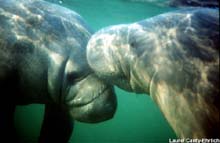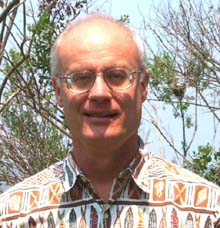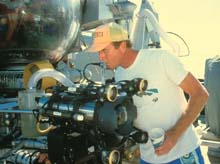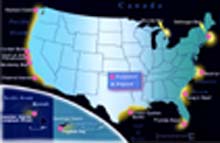September 10, 2001 - Web Chat
2:00 - 3:00 PM Eastern Time (11:00 - 12:00 PM Pacific Time)
Marine Protected Areas (MPAs)
Introduction
Panel of Experts
Preparation
Online Classroom Activities
Challenge Questions
Win a free Sustainable Seas Patch!
Introduction
People depend on marine resources everyday without even knowing it. Much of the food we eat and products we use come from the ocean. Because water covers two and a half times more of the Earth’s surface than land, the marine environment is a very important part of the world’s environment. When people began to realize how important the ocean and everything that lives in it are, the idea for marine protected areas was conceived.

Gentle creatures such as manatees have a better chance of survival in marine protected areas.
Within the last 20 years, Marine Protected Areas, also called MPAs, have become one of the most widely used methods to protect the oceans and the marine environment. MPAs can be thought of as parks like Yellowstone National Park in Montana and the Everglades in Florida. They are areas of water in the ocean that have special rules and laws telling you what you can and cannot do in them in order to protect the environment. Normally, MPAs are placed near the coast because that is where humans are using the resources too much.
Around the world biologists and economists have proven that the number of animals, especially fish, have increased tremendously inside MPA boundaries as opposed to outside those areas. Scientists have shown that there are several benefits to having marine protected areas: preventing species extinction, increasing the amount of fish to be caught, eliminating by-catch, protecting biodiversity, as well as increasing tourism as evidenced by the growing number of people wishing to visit the areas.
Panel of Experts

George R. Sedberry
George R. Sedberry was born in Tokyo, Japan, and spent his formative years on the Chesapeake Bay in Virginia, where he completed a B.S. degree in Biology at Old Dominion University, and the M.S. and Ph.D. degrees in Marine Science from the Virginia Institute of Marine Science, College of William and Mary. He is Senior Marine Scientist at the Marine Resources Research Institute of the South Carolina Department of Natural Resources (Charleston), where he has conducted research since 1980. His interests and experience are in the biology, conservation and management of reef fishes and highly migratory oceanic fishes, as well as deep sea biology and coral reef ecology. He serves on the Marine Protected Areas Advisory Panel and the Snapper/Grouper Assessment Panel of the South Atlantic Fishery Management Council, and is a member of the Gray’s Reef National Marine Sanctuary Advisory Council.

John K. Reed
John K. Reed is currently the Senior Research Specialist at the Harbor Branch Oceanographic Institution (HBOI), Division of Biomedical Marine Research. John is the supervisor for the Department of Collections and Taxonomy to discover new pharmaceutically active compounds from marine organisms. He is also responsible for curating 30,000 specimens of marine organisms in the taxonomic museum collection and is the Chief scientist in charge of organizing and supervising worldwide collection expeditions. Some of his other responsibilities include research proposals and research clearance permits, planning, logistics, collections, taxonomy, museum vouchers, photography, database management, dive supervision, cruise reports; submission of vouchers, photographs, videotapes, and cruise reports to foreign governments and U.S. State Department. John K. Reed obtained his B.S. degree in Biology from the University of Miami and his Masters specializing in marine ecology from Florida Atlantic University in Boca Raton, Florida.
Preparation
To help you prepare for the live event on September 10, the Islands in the Stream Education Team has provided some pointers to Web sites where you can learn more about the importance of Marine Protected Areas (MPAs).
We challenge you to answer some questions and hope that as you explore the suggested Web sites for answers, you will come up with some questions of your own to ask our experts, George Sedberry and John Reed. We invite you to leave your own questions in the chat room before the event, or ask them during the live program.
Online Classroom Activities
Take a dive ![]() into a kelp forest of one of the largest marine protected areas in the world
into a kelp forest of one of the largest marine protected areas in the world

There are 13 national marine sanctuaries around the country...is there one near you?
Challenge Questions
What are the names of the 13 National Marine Sanctuaries and where are they located?
Do all 13 sanctuaries have the same regulations when it comes to fishing (commercial and recreational) and oil drilling?
What are some of the overarching regulations that cover all 13 sanctuaries?
Information about the National Marine Sanctuary System
What are some of the regulations that have been made for MPAs?
Information about Marine Protected Areas
How many MPAs are there in the world?
Find out more from the World Commission on Protected Areas
What makes an MPA successful? What makes it a failure?
The Cousteau Society's Marine Proteced Areas: Call for Action
Read a Joint Fishermen's Letter of MPA Standards
What percentage of the US coastline is recognized as an MPA?
Information about the National Marine Sanctuary System ![]()
What is the difference between a MPA and a marine reserve?
What is a MPA?
Bonus Question
Where were the first deep-water reefs in the world to be designated a marine protected area?
Hint: NOAA's Islands in the Stream--South Atlantic Bight Mission will be visiting this site during the first leg of the expedition.
Win a free Sustainable Seas Patch!
Email your answers to the challenge question to win a free Sustainable Seas Expeditions patch!
Sign up for the Ocean Explorer E-mail Update List.











































